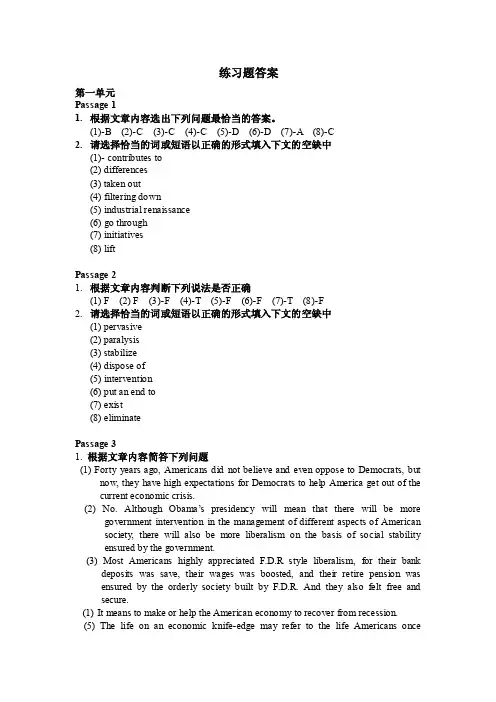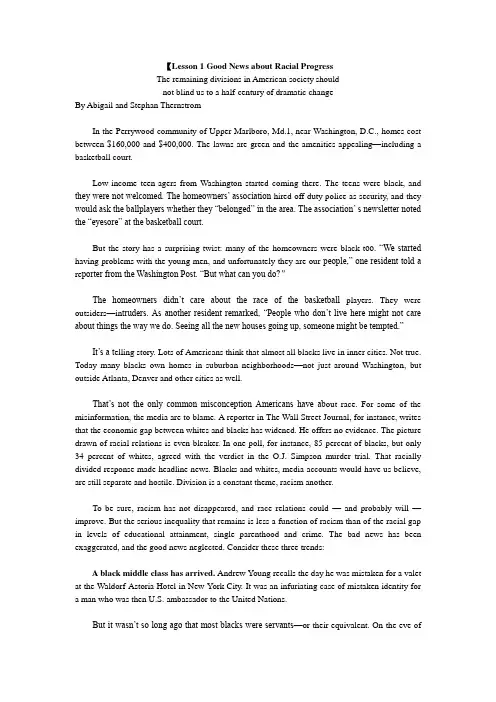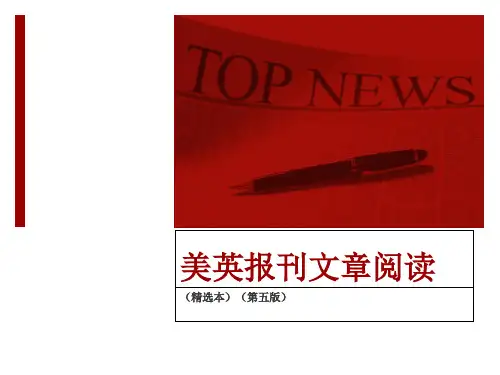英美报刊阅读-1
- 格式:ppt
- 大小:709.50 KB
- 文档页数:65




练习题答案第一单元Passage 11.根据文章内容选出下列问题最恰当的答案。
(1)-B (2)-C (3)-C (4)-C (5)-D (6)-D (7)-A (8)-C2.请选择恰当的词或短语以正确的形式填入下文的空缺中(1)- contributes to(2) differences(3) taken out(4) filtering down(5) industrial renaissance(6) go through(7) initiatives(8) liftPassage 21.根据文章内容判断下列说法是否正确(1) F (2) F (3)-F (4)-T (5)-F (6)-F (7)-T (8)-F2.请选择恰当的词或短语以正确的形式填入下文的空缺中(1) pervasive(2) paralysis(3) stabilize(4) dispose of(5) intervention(6) put an end to(7) exist(8) eliminatePassage 31.根据文章内容简答下列问题(1) Forty years ago, Americans did not believe and even oppose to Democrats, butnow, they have high expectations for Democrats to help America get out of the current economic crisis.(2) No. Although Obama’s presidency will mean that there will be moregovernment intervention in the management of different aspects of American society, there will also be more liberalism on the basis of social stability ensured by the government.(3) Most Americans highly appreciated F.D.R style liberalism, for their bankdeposits was save, their wages was boosted, and their retire pension was ensured by the orderly society built by F.D.R. And they also felt free and secure.(1)It means to make or help the American economy to recover from recession. (5) The life on an economic knife-edge may refer to the life Americans onceexperienced in 1930s depression and the life they are experiencing in current economic crisis. Such life can be characterized by high unemployment rate, banking panics, stock market crashes, the bursting of other financial bubbles, currency crises, and sovereign defaults.(6) The conservative economic agenda just like the liberal cultural agenda of the1960s, it was less liberating than frightening, and was focused on cultural order instead of economic order.(7) Obama’s great challenge and great opportunity is whether he will establish anew liberal order with more control by his big government to free America from the current economic depression and to build up a good welfare system for Americans.(8) The focus of New Liberal Order to Americans now should shift from the culturalorder to economic order.2. 请选择恰当的词或短语以正确的形式填入下文的空缺中(1) opposing(2) ranging from(3) exist(4) guaranteeing(5) tyranny(6) high-water ranks(7) concept(8) self-reliance第二单元Passage 11.Decide whether the following statements are true (T) or false (F)(1) T (2) T (3) T (4) F (5) T (6) F (7) T (8) T (9) F (10) F2.请选择恰当的词或短语以正确的形式填入下文的空缺中。
![2024版美英报刊阅读ppt课件[1]](https://uimg.taocdn.com/25b823cc82d049649b6648d7c1c708a1284a0aa2.webp)

【Lesson 1 Good News about Racial ProgressThe remaining divisions in American society shouldnot blind us to a half-century of dramatic changeBy Abigail and Stephan ThernstromIn the Perrywood community of Upper Marlboro, Md.1, near Washington, D.C., homes cost between $160,000 and $400,000. The lawns are green and the amenities appealing—including a basketball court.Low-income teen-agers from Washington started coming there. The teens were black, and they were not welcomed. The homeowners’ association hired off-duty police as security, and they would ask the ballplayers whether they “belonged” in the area. The association’ s newsletter noted the “eyesore” at the basketball court.But the story has a surprising twist: many of the homeowners were black t oo. “We started having problems with the young men, and unfortunately they are our people,” one resident told a re porter from the Washington Post. “But what can you do?”The homeowners didn’t care about the race of the basketball players. They were outsiders—in truders. As another resident remarked, “People who don’t live here might not care about things the way we do. Seeing all the new houses going up, someone might be tempted.”It’s a t elling story. Lots of Americans think that almost all blacks live in inner cities. Not true. Today many blacks own homes in suburban neighborhoods—not just around Washington, but outside Atlanta, Denver and other cities as well.That’s not the only common misconception Americans have ab out race. For some of the misinformation, the media are to blame. A reporter in The Wall Street Journal, for instance, writes that the economic gap between whites and blacks has widened. He offers no evidence. The picture drawn of racial relations is even bleaker. In one poll, for instance, 85 percent of blacks, but only 34 percent of whites, agreed with the verdict in the O.J. Simpson murder trial. That racially divided response made headline news. Blacks and whites, media accounts would have us believe, are still separate and hostile. Division is a constant theme, racism another.To be sure, racism has not disappeared, and race relations could —and probably will —improve. But the serious inequality that remains is less a function of racism than of the racial gap in levels of educational attainment, single parenthood and crime. The bad news has been exaggerated, and the good news neglected. Consider these three trends:A black middle class has arrived. Andrew Young recalls the day he was mistaken for a valet at the Waldorf-Astoria Hotel in New York City. It was an infuriating case of mistaken identity for a man who was then U.S. ambassador to the United Nations.But it wasn’t so long ago that most blacks were servants—or their equivalent. On the eve ofWorld War II, a trivial five percent of black men were engaged in white-collar work of any kind, and six out of ten African-American women were employed as domestics.In 1940 there were only 1,000 practicing African-American lawyers; by 1995 there were over 32,000, about four percent of all attorneys.Today almost three-quarters of African-American families have incomes above the government poverty line. Many are in the middle class, according to one useful index—earning double the government poverty level; in 1995 this was $30,910 for a two-parent family with two children and $40,728 for a two-parent family with four children. Only one black family in 100 enjoyed a middle-class income in 1940; by 1995 it was 49 in 100. And more than 40 percent of black households also own their homes. That’ s a huge change.The typical white family still earns a lot more than the black family because it is more likely to collect two paychecks. But if we look only at married couples—much of the middle class—the white-black income gap shrinks to 13 percent. Much of that gap can be explained by the smaller percentage of blacks with college degrees, which boost wages, and the greater concentration of blacks in the South, where wages tend to be lower.Blacks are moving to the suburbs. Following the urban riots of the mid-1960s, the presidential Kerner Commission14 concluded that the nation’ s future was menaced by “accelerating segregation”—black central cities and whites outside the core. That segregation might well blow the country apart, it said.It’ s true that whites have continued to leave inner cities for the suburbs, but so, too, have blacks. The number of black suburban dwellers in the last generation has almost tripled to 10.6 million. In 1970 metropolitan Atlanta, for example, 27 percent of blacks lived in the suburbs with 85 percent of whites. By 1990, 64 percent of blacks and 94 percent of whites resided there.This is not phony integration, with blacks moving from one all-black neighborhood into another. Most of the movement has brought African-Americans into neighborhoods much less black15 than those they left behind, thus increasing integration. By 1994 six in ten whites reported that they lived in neighborhoods with blacks.Residential patterns do remain closely connected to race. However, neighborhoods have become more racially mixed, and residential segregation has been decreasing.Bigotry has declined. Before World Was ft, Gunnar Myrdal16 roamed the South researching An American Dilemma, the now-classic book that documented17 the chasm betwe en the nation’s ideals and its racial practices, hi one small Southern city, he kept asking whites how he could find “Mr. Jim Smith,” an African-American who was principal of a black high school. No one seemed to know who he was. After he finally found Smith, Myrdal was told that he should have just asked for “Jim.” That’ s how great was white aversion to dignifying African-Americans with “Mr.” Or “Mrs.”Bigotry was not just a Southern problem. A national survey in the 1940s asked whether “Ne-groes shoul d have as good a chance as white people to get any kind of job.” A majority of whites said that “white people should have the first chance at any kind of job.”19. Such a question would not even be asked today. Except for a lunatic fringe18, no whites would sign on to such a notion.1920. In 1964 less than one in five whites reported having a black friend. By 1989 more than two out of three did. And more than eight often African -Americans had a white friend.21. What about the last taboo?20 In 1963 ten percent of whites approved of black-white dating; by 1994 it was 65 percent. Interracial marriages? Four percent of whites said it was okay in 1958; by 1994 the figure had climbed more than elevenfold, to 45 percent. These surveys measure opinion, but behavior has also changed. In 1963 less than one percent of marriages by African- Americans were racially mixed. By 1993, 12 percent were.22. Today black Americans can climb the ladder to the top.21 Ann M. Fudge is already there; she’s in charge of manufacturing, promotion and sales at the $2.7-billion Maxwell House Coffee and Post Cereals divisions of Kraft Foods.22 So are Kenneth Chenault, president and chief operating officer at American Express23 and Richard D. Parsons, president of Time Warner, Inc.24 After the 1988 Demo-cratic Convention25, the Rev. Jesse Jackson26 talked about his chances of making it to the White House. “I may not get there,” he said “But it is possible for our children to get there now.”23. Even that seems too pessimistic. Consider how things have improved since Colin and Alma Powell27 packed their belongings into a V olkswagen28 and left Fort Devens, Mass., for Fort Bragg, N. C. “I remember passing Woodbridgc, Va.,” General Powell wrote in his autobiogra phy, “and not finding even a gas-station bathroom that we were allowed to use.” That was in 1962. In 1996 reliable polls suggest he could have been elected President.24. Progress over the last half-century has been dramatic. As Corctta Scott King wrote not long ago, the ideals for which her husband Martin Luther King Jr. died, have become “deeply embedded in the very fabric of America29.”From Reader’s Digest, March, 1998V. Analysis of Content1. According to the author, ___________A. racism has disappeared in AmericaB. little progress has been made in race relationsC. media reports have exaggerated the racial gapD. media accounts have made people believe that the gap between blacks and whites has become narrower2. What the Kerner Commi ssion meant by “accelerating segregation” was that __________A. more and more whites and blacks were forced to live and work separatelyB. more and more blacks lived in the central cities, and whites outside the coreC. more and more whites lived in the central cities, and blacks outside the coreD. nowadays more and more blacks begin to live in the suburbs3. The last taboo in the article is about ____________.A. political status of America’s minority peopleB. economic status of America’ s minori ty peopleC. racial integrationD. interracial marriages4. Gunnar Myrdal kept asking whites how he could find “Mr. Jim Smith,” but no one seemed to know who he was, because _____________.A. there was not such a person called Jim SmithB. Jim Smith was not famousC. the whites didn ‘t know Jim SmithD. the white people considered that a black man did not deserve the title of “Mr.”5. In the author’s opinion, _A. few black Americans can climb the ladder to the topB. Jesse Jackson’ s words in th is article seemed too pessimisticC. Colin Powell could never have been elected PresidentD. blacks can never become America’ s PresidentVI. Questions on the Article1. Why were those low-income teen-agers who came to the Perrywood community consid-ered to be “the eyesore”?2. What is the surprising twist of the story?3. According to this article, what has caused much of the white-black income gap?4. Why did the presidential Kerner Commission conclude that the nation’ s future was menaced by “accelerating segregation”?5. Why wouldn’t questions as “Should negroes have as good a chance as white people to get any kind of job?” be asked today?Topics for Discussion1. Can you tell briefly the dramatic progress in the status of America’ s minority p eople over the last half-century?2. Do you think the article is unbiased? What do you think of the author s view on the African-Americans?1. amenity: n. A. The quality of being pleasant or attractive; agreeableness. 怡人:使人愉快或吸引人的性质;使人愉快 B. A feature that increases attractiveness or value, especially of a piece of real estate or a geographic location.生活福利设施;便利设施:能够增加吸引力或价值的事物,特别是不动产或地理位置⊙ We enjoy all the -ties of home life. 我们享受家庭生活的一切乐趣。




美英报刊阅读教程Lesson1课文【Lesson 1 Good News about Racial ProgressThe remaining divisions in American society shouldnot blind us to a half-century of dramatic changeBy Abigail and Stephan ThernstromIn the Perrywood community of Upper Marlboro, Md.1, near Washington, D.C., homes cost between $160,000 and $400,000. The lawns are green and the amenities appealing—including a basketball court.Low-income teen-agers from Washington started coming there. The teens were black, and they were not welcomed. The homeowners? association hired off-duty police as security, and they would ask the ballplayers whether they “belonged” in the area. The association? s newsletter noted the “eyesore” at the basketball court.But the story has a surprising twist: many of the homeowners were black t oo. “We started having problems with the young men, and unfortunately they are our people,” one resident told a re porter from the Washington Post. “But what can you do?”The homeowners didn?t care about the race of the basketball players. They were outsiders—in truders. As another resident remarked, “People who don?t live here might not care about things the way we do. Seeing all the new houses going up, someone might b e tempted.”It?s a t elling story. Lots of Americans think that almost all blacks live in inner cities. Not true. Today many blacks own homes in suburban neighborhoods—not just around Washington, but outside Atlanta, Denver and other cities as well.That?s not the only common misconception Americans haveab out race. For some of the misinformation, the media are to blame. A reporter in The Wall Street Journal, for instance, writes that the economic gap between whites and blacks has widened. He offers no evidence. The picture drawn of racial relations is even bleaker. In one poll, for instance, 85 percent of blacks, but only 34 percent of whites, agreed with the verdict in the O.J. Simpson murder trial. That racially divided response made headline news. Blacks and whites, media accounts would have us believe, are still separate and hostile. Division is a constant theme, racism another.To be sure, racism has not disappeared, and race relations could —and probably will —improve. But the serious inequality that remains is less a function of racism than of the racial gap in levels of educational attainment, single parenthood and crime. The bad news has been exaggerated, and the good news neglected. Consider these three trends:A black middle class has arrived. Andrew Young recalls the day he was mistaken for a valet at the Waldorf-Astoria Hotel in New York City. It was an infuriating case of mistaken identity for a man who was then U.S. ambassador to the United Nations.But it wasn?t so long ago that most blacks were servants—or their equivalent. On the eve ofWorld War II, a trivial five percent of black men were engaged in white-collar work of any kind, and six out of ten African-American women were employed as domestics.In 1940 there were only 1,000 practicing African-American lawyers; by 1995 there were over 32,000, about four percent of all attorneys.Today almost three-quarters of African-American families have incomes above the government poverty line. Many are inthe middle class, according to one useful index—earning double the government poverty level; in 1995 this was $30,910 for a two-parent family with two children and $40,728 for a two-parent family with four children. Only one black family in 100 enjoyed a middle-class income in 1940; by 1995 it was 49 in 100. And more than 40 percent of black households also own their homes. That? s a huge change.The typical white family still earns a lot more than the black family because it is more likely to collect two paychecks. But if we look only at married couples—much of the middle class—the white-black income gap shrinks to 13 percent. Much of that gap can be explained by the smaller percentage of blacks with college degrees, which boost wages, and the greater concentration of blacks in the South, where wages tend to be lower.Blacks are moving to the suburbs. Following the urban riots of the mid-1960s, the presiden-tial Kerner Commission14 concluded that the nation? s future was menaced by “accelerating segrega-tion”—black central cities and whites outside the core. That segregation might well blow the country apart, it said.It? s true that whites have continued to leave inner cities for the suburbs, but so, too, have blacks. The number of black suburban dwellers in the last generation has almost tripled to 10.6 million. In 1970 metropolitan Atlanta, for example, 27 percent of blacks lived in the suburbs with 85 percent of whites. By 1990, 64 percent of blacks and 94 percent of whites resided there.This is not phony integration, with blacks moving from one all-black neighborhood into another. Most of the movement has brought African-Americans into neighborhoods much lessblack15 than those they left behind, thus increasing integration. By 1994 six in ten whites reported that they lived in neighborhoods with blacks.Residential patterns do remain closely connected to race. However, neighborhoods have become more racially mixed, and residential segregation has been decreasing.Bigotry has declined. Before World Was ft, Gunnar Myrdal16 roamed the South researching An American Dilemma, the now-classic book that documented17 the chasm betwe en the nation?s ideals and its racial practices, hi one small Southern city, he kept asking whites how he could find “Mr. Jim Smith,” an African-American who was principal of a black high school. No one seemed to know who he was. After he finally found Smith, Myrdal was told that he should have just asked for “Jim.” That? s how great was white aversion to dignifying African-Americans with “Mr.” Or “Mrs.”Bigotry was not just a Southern problem. A national survey in the 1940s asked whether “Ne-groes shoul d have as good a chance as white people to get any kind of job.” A majority of whites said that “white people should have the first chance at any kind of job.”19. Such a question would not even be asked today. Except for a lunatic fringe18, no whites would sign on to such a notion.1920. In 1964 less than one in five whites reported having a black friend. By 1989 more than two out of three did. And more than eight often African -Americans had a white friend.21. What about the last taboo?20 In 1963 ten percent of whites approved of black-white dating; by 1994 it was 65 percent. Interracial marriages? Four percent of whites said it was okay in1958; by 1994 the figure had climbed more than elevenfold, to 45 percent. These surveys measure opinion, but behavior has also changed. In 1963 less than one percent of marriages by African- Americans were racially mixed. By 1993, 12 percent were.22. Today black Americans can climb the ladder to the top.21 Ann M. Fudge is already there; she?s in charge of manufacturing, promotion and sales at the $2.7-billion Maxwell House Coffee and Post Cereals divisions of Kraft Foods.22 So are Kenneth Chenault, president and chief operating officer at American Express23 and Richard D. Parsons, president of Time Warner, Inc.24 After the 1988 Demo-cratic Convention25, the Rev. Jesse Jackson26 talked about his chances of making it to the White House. “I may not get there,” he said “But it is possible for our child ren to get there now.”23. Even that seems too pessimistic. Consider how things have improved since Colin and Alma Powell27 packed their belongings into a V olkswagen28 and left Fort Devens, Mass., for Fort Bragg, N. C. “I remember passing Woodbridgc, Va.,” General Powell wrote in his autobiogra phy, “and not finding even a gas-station bathroom that we were allowed to use.” That was in 1962. In 1996 reliable polls suggest he could have been elected President.24. Progress over the last half-century has been dramatic. As Corctta Scott King wrote not long ago, the ideals for which her husband Martin Luther King Jr. died, have become “deeply embedded in the very fabric of America29.”From Reader?s Digest, March, 1998V. Analysis of Content1. According to the author, ___________A. racism has disappeared in AmericaB. little progress has been made in race relationsC. media reports have exaggerated the racial gapD. media accounts have made people believe that the gap between blacks and whites has become narrower2. What the Kerner Commi ssion meant by “accelerating segregation” was that __________A. more and more whites and blacks were forced to live and work separatelyB. more and more blacks lived in the central cities, and whites outside the coreC. more and more whites lived in the central cities, and blacks outside the coreD. nowadays more and more blacks begin to live in the suburbs3. The last taboo in the article is about ____________.A. political status of America?s minority peopleB. economic status of America? s minori ty peopleC. racial integrationD. interracial marriages4. Gunnar Myrdal kept asking whites how he could find “Mr. Jim Smith,” but no one seemed to know who he was, because _____________.A. there was not such a person called Jim SmithB. Jim Smith was not famousC. the whites didn …t know Jim SmithD. the white people considered that a black man did not deserve the title of “Mr.”5. In the author?s opinion, _A. few black Americans can climb the ladder to the topB. Jesse Jackson? s words in th is article seemed toopessimisticC. Colin Powell could never have been elected PresidentD. blacks can never become America? s PresidentVI. Questions on the Article1. Why were those low-income teen-agers who came to the Perrywood community consid-ered to be “the eyesore”?2. What is the surprising twist of the story?3. According to this article, what has caused much of the white-black income gap?4. Why did the presidential Kerner Commission conclude that the nation? s future was menaced by “accelerating segregation”?5. Why wouldn?t questions as “Should negroes have as good a chance as white people to get any kind of job?” be asked today?Topics for Discussion1. Can you tell briefly the dramatic progress in the status of America? s minority p eople over the last half-century?2. Do you think the article is unbiased? What do you think of the author s view on the African-Americans?1. amenity: n. A. The quality of being pleasant or attractive; agreeableness. 怡人:使人愉快或吸引人的性质;使人愉快B. A feature that increases attractiveness or value, especially of a piece of real estate or a geographic location.生活福利设施;便利设施:能够增加吸引力或价值的事物,特别是不动产或地理位置⊙ We enjoy all the -ties of home life. 我们享受家庭生活的一切乐趣。

Home at last这是其中的一个通宵gabfests学生在毕业时,他们将友情,裸露最深的感觉。
只有这是更严重的:11同学聚集在公寓在哈佛商学院校园1999年5月,是中国的命运抗争。
包围着空啤酒瓶和包薯片,朋友们——所有来自中国大陆——正在讨论是否要回家了。
他们每个人都已经收到了来自美国顶尖的公司。
当然,中国发生了巨大变化的十年以来,他们中的大多数人都离开了。
政治和抗议仍是禁忌,但美国现在提供了更多的个人自由和经济的机会比以往任何时候都多。
和它急需精英经理喜欢他们。
张伟,一个活跃的29岁女性的梦想是成为中国的美国脱口秀主持人奥普拉·温芙瑞,恳求她的同学凭著他们回家。
“我们不会牺牲现在为了明天,”她说。
“我们应该马上做我们真正想做的事。
”这个词是纯粹的金钱,但他们证明预言。
在几周的时间里,也不愿在这房间里的最年轻的人——一个26岁的前国家数学冠军名叫哨Yibo——那里商业建议、出售他的财产留给了上海,他在那里举行中国版的网上拍卖巨人易趣。
在路上,他停下来休息一天在硅谷和说服投资者给他40万美元。
几周之后,同学镡海鹰回到上海拜访朋友开始之前一个银行的工作在纽约。
她从不使用她的回程机票到美国:邵说服她去参加他的公司的首席运营官。
三其他成员在一年之内的小团体——欢一茗,妮陈和赫伯特王建民——也回发射启动公司。
和张吗?她的工作是business-development降落在鲁珀特·默多克新闻集团在北京。
她也加班追求金钱的梦想。
一旦一个星期她主持一个受欢迎的电视脱口秀节目,在北京的主题是如此大胆艾滋病、药物滥用和——是的——网上约会。
长时间的中国学生聚集在HBS的,他们并不是寻找一个逃跑,但是他们最终的边缘。
经过多年的咨询公司,跨国公司或创业,所有的人都觉得需要更进一步的了解西方商业文化。
哈佛,中国学生迅速移聚在一起。
旧的手帮助新来的人学会开车,买菜,乘坐地铁。
三个人一起住在一所公寓里,因为他们煮中国菜,事情很快就成了。
The Sino-Japanese Naval War of 2012OK, it's probably not going to happen. But if it did, who would win?From Foreign Policy of August 24,2012Lord Wellington depicted the allied triumph(盟军的胜利)at Waterloo as "the nearest-run thing(最势均力敌的较量)you ever saw in your life." Wellington's verdict would describe the likely outcome should Chinese and Japanese forces meet in battle over theSenkaku/Diaoyu Islands, or elsewhere off the Northeast Asian seaboard. Such a fight appeared farfetched(牵强的,靠不住的)before 2010, when Japan's Coast Guard apprehended(逮捕)Chinese fishermen who rammed one of its vessels off the disputed islands, but it appears more likely now. After Japan detained and deported(扣押并遣送)Chinese activists who landed on the disputed islands in mid-August, a hawkish(鹰派的)Chinese major general(少将), Luo Yuan, called on China to dispatch(派遣)100 boats to defend the Diaoyus. In an op-ed(专栏版)published Aug. 20, the nationalistic Chinese broadsheet Global Times(环球时报的大幅纸张)warned, "Japan will pay a price for its actions ... and the result will be far worse than they anticipated."This is more than mere posturing(故作姿态). In July, China's East Sea Fleet(舰队)conducted an exercise simulating an amphibious(水陆两栖的)assault on the islands. China's leaders are clearly thinking about the unthinkable(未雨绸缪). And with protesters taking to the streets(上街游行)to smash(砸碎)Japanese cars and attack sushi restaurants, their people may be behind them(民众可能是政府强有力的后盾). So who would win the unlikely prospect of a clash of titan s in the Pacific(两位太平洋巨人): China or Japan?Despite Japan's latter-day(当今的)image as a military pushover(军事小国), a naval war would not be a rout(溃败)for China. While the Japanese postwar "peace" constitution (和平宪法)"forever renounces war as a sovereign right of the nation and the threat or use of force as means of settling international disputes,"(永远放弃自己作为主权国家使用武力解决国际纠纷的权力)the Japan Maritime Self-Defense Force (JMSDF) has accumulated several pockets of material excellence,(存有几幅好牌)such as undersea warfare, since World War II. And Japanese mariners(海员)are renowned for their professionalism. If commanders manage their human, material, (调兵遣将)and geographic advantages artfully, Tokyo could make a maritime war(海战)with China a close-run thing(旗鼓相当)-- and perhaps even prevail(更胜一筹).Past naval wars between the two rivals set the stage for today's island controversy. During the Sino-Japanese War of 1894-1895, a fleet engagement turned Asia's Sinocentric order upside down in an afternoon. The Imperial Japanese Navy, hurriedly cobbled together from imported hulls and components following Japan's Meiji Restoration, smashedChina's Beiyang Fleet, a force widely considered superior in material terms. The September 1894 Battle of the Yalu River was won by the navy with superior seamanship,gunnery, and morale. While Japan is no longer a rising power, the JMSDF has preserved a culture of human excellence.If a rerun of the Battle of the Yalu takes place, how would Japan's navy match up against China's? This is admittedly an improbable scenario. A straightforward China-on-Japan war is doubtful unless Beijing manages to isolate Tokyo diplomatically -- as wise practitioners of limited war attempt to do -- or Tokyo isolates itself through foolish diplomacy. Barring that, a conflict would probably ensnare the United States as an active combatant on the Japanese side. War is a political act -- "statesmanship directing arms," as naval historian Alfred Thayer Mahan puts it -- but let's discount politics for now and look at the prospects of war in strictly military terms, as a contest between Chinese and Japanese sea power.In raw numerical terms, there is no contest. Japan's navy boasts 48 "major surface combatants," ships designed to attack enemy main fleets while taking a pounding themselves. For the JMSDF these include "helicopter destroyers," or light aircraft carriers; guided-missile destroyers equipped with the state-of-the-art Aegis combat system, a combination radar, computer, and fire-control system found in frontline U.S. Navy warships; and an assortment of lesser destroyers, frigates, and corvettes. A squadron of 16 diesel-electric submarines augments the surface fleet. Juxtapose this against the PLA Navy's 73 major surface combatants, 84 missile-firing patrol craft, and 63 submarines, and the bidding appears grim for Japan. China's navy is far superior in sheer weight of steel.But raw numbers can be misleading, for three main reasons. First, as strategist Edward Luttwak has observed, weapons are like "black boxes" until actually used in combat: no one knows for sure whether they will perform as advertised. Battle, not t echnical specifications, is the true arbiter of military technology's value. Accurately forecasting how ships, planes, and missiles will perform amid the stresses and chaos of combat thus verges on impossible. This is especially true, adds Luttwak, when conflict pits an open society against a closed one. Open societies have a habit of debating their military failings in public, whereas closed societies tend to keep their deficiencies out of view. Luttwak was referring to the U.S.-Soviet naval competition, but it applies to Sino-Japanese competition as well. The Soviet Navy appeared imposing on paper. But Soviet warships on the high seas during the Cold War showed unmistakable symptoms of decay, from slipshod shiphandling to rusty hulls. The PLA Navy could be hiding something as well. The quality of the JMSDF's platforms, and its human capabilities, could partially or wholly offset the PLA's advantage of numbers.Second, there's the human variable in warfare. In his classic account, The Naval War of 1812, Theodore Roosevelt explained the U.S. Navy's success in single-ship duels against Britain's Royal Navy as a product of quality ship design and construction and superior fighting prowess: in other words, of material and human factors. The latter is measured in seamanship, gunnery, and the myriad of traits that set one navy apart from others. Mariners hone these traits not by sitting in port and polishing their equipment but by goingto sea. JMSDF flotillas ply Asian waters continually, operating solo or with other navies. The PLA Navy is inert by comparison. With the exception of a counter-piracy deployment to the Gulf of Aden that began in 2009, Chinese fleets emerge only for brief cruises or exercises, leaving crews little time to develop an operating rhythm, learn their profession, or build healthy habits. The human edge goes to Japan.And three, it's misleading to reduce the problem solely to fleets. There will be no purely fleet-on-fleet engagement in Northeast Asia. Geography situated the two Asian titans close to each other: their landmasses, including outlying islands, are unsinkable aircraft carriers and missile firing platforms. Suitably armed and fortified, land-based sites constitute formidable implements of sea power. So we need to factor in both countries' land-based firepower.Japan forms the northern arc of the first island chain that envelops the Asian coastline, forming the eastern frontier of the Yellow and East China seas. No island between the Tsushima Strait (which separates Japan from Korea) and Taiwan lies more than 500 miles off China's coast. Most, including the Senkakus/Diaoyus, are far closer. Within these cramped waters, any likely battleground would fall within range of shore-based firepower. Both militaries field tactical aircraft that boast the combat radius to strike throughout the Yellow and East China seas and into the Western Pacific. Both possess shore-firedanti-ship cruise missiles (ASCMs) and can add their hitting power to the mix.There are some asymmetries, however. PLA conventional ballistic missiles can strike at land sites throughout Asia, putting Japanese assets at risk before they ever leave port or take to the sky. And China's Second Artillery Corps, or missile force, has reportedly fielded anti-ship ballistic missiles (ASBMs) able to strike at moving ships at sea from the mainland. With a range estimated at more than 900 miles, the ASBM could strike anywhere in the China seas, at seaports throughout the Japanese islands, and far beyond.Consider the Senkakus, the hardest assets to defend from the Japanese standpoint. They lie near the southwestern tip of the Ryukyu chain, closer to Taiwan than to Okinawa or Japan's major islands. Defending them from distant bases would be difficult. But if Japan forward-deployed Type 88 ASCMs -- mobile, easily transportable anti-ship weapons -- and missile crews to the islets and to neighboring islands in the Ryukyu chain, its ground troops could generate overlapping fields of fire that would convert nearby seas into no-go zones for Chinese shipping. Once dug in, they would be tough to dislodge, even for determined Chinese rocketeers and airmen.Whoever forges sea, land, and air forces into the sharpest weapon of sea combat stands a good chance of prevailing. That could be Japan if its political and military leaders think creatively, procure the right hardware, and arrange it on the map for maximum effect. After all, Japan doesn't need to defeat China's military in order to win a showdown at sea, because it already holds the contested real estate; all it needs to do is deny China access.If Northeast Asian seas became a no-man's land but Japanese forces hung on, the political victory would be Tokyo's.Japan also enjoys the luxury of concentrating its forces at home, whereas the PLA Navy is dispersed into three fleets spread along China's lengthy coastline. Chinese commanders face a dilemma: If they concentrate forces to amass numerical superiority during hostilities with Japan, they risk leaving other interests uncovered. It would be hazardous for Beijing to leave, say, the South China Sea unguarded during a conflict in the northeast.And finally, Chinese leaders would be forced to consider how far a marine war would set back their sea-power project. China has staked its economic and diplomatic future in large part on a powerful oceangoing navy. In December 2006, President Hu Jintao ordered PLA commanders to construct "a powerful people's navy" that could defend the nation's maritime lifelines -- in particular sea lanes that connect Indian Ocean energy exporters with users in China -- "at any time." That takes lots of ships. If it lost much of the fleet in a Sino-Japanese clash -- even in a winning effort -- Beijing could see its momentum toward world-power status reversed in an afternoon.Here's hoping China's political and military leaders understand all this. If so, the Great Sino-Japanese Naval War of 2012 won't be happening outside these pages.。
Lesson one Home at last1. Not only had China changed dramatically since most of them had left but also the nation could offer more personal freedoms and economic opportunities than ever before.2. Most of them like to go in for ecommerce.3. Because IT is the leading industry now.4. They want to gain experience in the States before they come back.5. It is the complicated relationship and the uncertainty of our human resource management system.6. It means some of the HBS elite have made their final decision to return to China to serve their country.Lesson two1.Osaka: nearly complet exclusion of non-JP companies from the project , built at the zenith of JP’seconomic powerGuangzhou: nearly completely designed and engineered by foreign companies, developing country with low-wage work force.2.Openness combined with China’s vast population of 1.3 billion. Potential size of its market.3.Its immense and low-paid work force.4.第一小问:Not necessary.第二:Yes, it is especially susceptible to economic booms and busts. At the same time, China’s one-party system may struggle to adapt to the social tensions brought to the surface by rapid economicdevelopment.第三:No, China’s strengths and using the experience of JP for reference.5.Fast development +vast population of 1.3 billion+ military muscle +increasing trade surplus.第二问:Trade with China. Cheaper labor=Cheaper products=preference of made-in-China=fewer sale of made-in US=fewer products of US factories=fewer job forUS.第三问;No, China’s strengths,especially the cheap labor advantage are partially the reason of theunemployment in US. The fast development cannot being undertaking without drawing any attention or attack.6.Susceptible to economic booms and bustsEconomic bubbleUnemployed adultsAcute setbacksLesson Three China finds western ways bring news woes1. The writer thinks that the best way to appreciate how much changed in China has is to examine the people themselves: what they eat and drink now and how dangerously overweight more than one-fifth of adults are.2. Traditional Chinese lifestyle emphasizes restraint while the Western lifestyle emphasizes indulgence. The change from Traditional lifestyle to Western indulgence will affect public health strongly: deaths fromdiet-related illnesses are expected to increase 10 times faster than population growth. And the increase in health care costs could slow down the economic development.3. Less exercise and more fat in the diet. Because people have more money than before.4. YES. He believes that increased supplies of alcohol, together with the rising disposable income, have stimulated drinking.5. YES. Unhealthy eating and drinking may cause diseases like heart attack, stroke and adult-onset diabetes, and the government will have to spend more money to treat these diseases.Lesson four 保护名胜古迹刻不容缓1.What activities are harming ancient Buddhist grottoes?Too many tourists and their breathing are harming them.2.Who turned the caves into the painted shrines?It was the travelers along the old silk road.3.Are murals in good shape.No, they are not in good shape. Many of them are already sagging or peeling from walls, and their delicate beauty is fading away. Others have deteriorated beyond repair efforts.4.Why is it difficult for the authorities to prevent them from being destroyed?Money is at the root of the problem. China is a poor nation. Local governments have little money left over for cultural conservation.5.Does the Chinese government value the preservation of those historical and cultural sites?Yes, it does. For instance, it has given award to the Getty Conservation Institute for its contributions to the preservation of them at Dunhuang.6.Why did Mr. Neville Agn ew say “ tourism and conservation are good partners”?If you can make a good connection, they are. In other words, if you can allocate part of the money earned from tourism to conservation, and don’t turn to tourism as a cash cow, they will be good partners.Lesson five The evolution wars1. in the late fall. This is a challenge to Darwin’s theory which is widely regarded as one of the best-supported ideas in science since it comes from decades of study and objective evidence. Till now Darwin’s theory is the only explanation for the rich variety of life forms on Earth, so scientists fell horrible.2. Bush supports the idea of introducing both evolutionism and intelligent design in biology class. His attitude will further provoke battles on the topic and even bring more political and competitive pressure on science.3. NO. Because Darwin’s theory has conflicted with people’s religious convictions. The “monkey trial” was a famous case, in which Tennessee school teacher was convicted of violating the ban of teaching evolution in 1925. That was a big war between creationism and evolutionism.4. Living things are too exquisitely complex to have evolved by a combination of chance mutations and natural selection. Some pieces in the fossil record that may prove the evolution process are missing.5. NO. The earlier anti-Darwinists, mostly creationists, regarded evolution as a heresy and they openly claimed the role of God. But the proponents of intelligent design accept some role of evolution and they avoid bringing God into the discussion.6. They think the intelligent design is faith-based, so the debate about evolution is not a real scientific argument.7. Because it is difficult for people to argue over such benign and earnest language. This can even make people feel the theory a scientific one and avoid violation against the Constitution.8. 开放性问题。